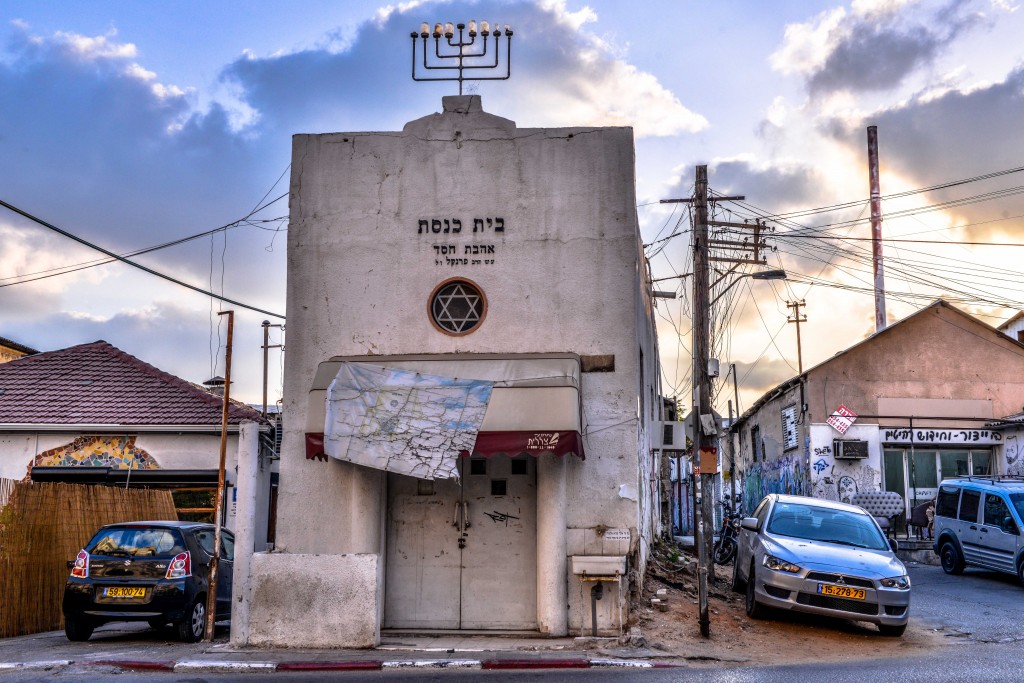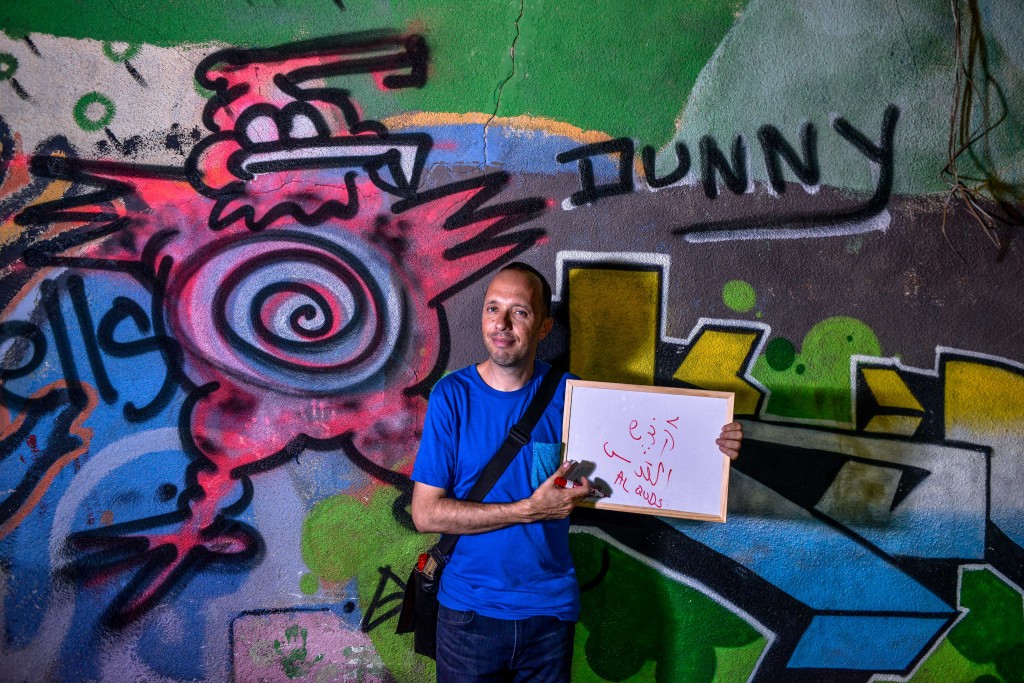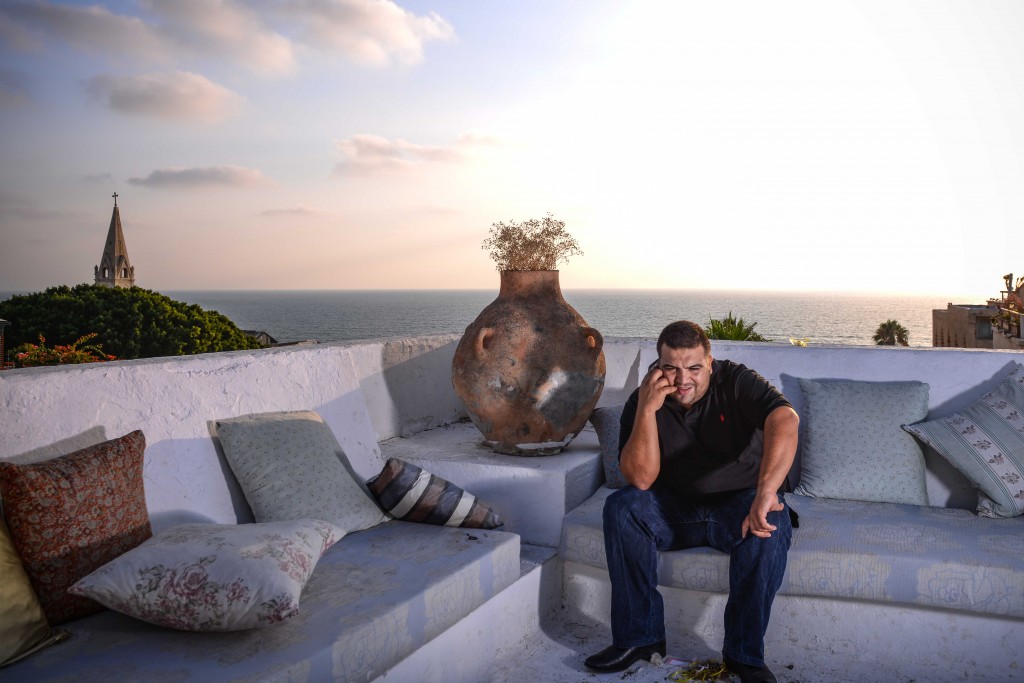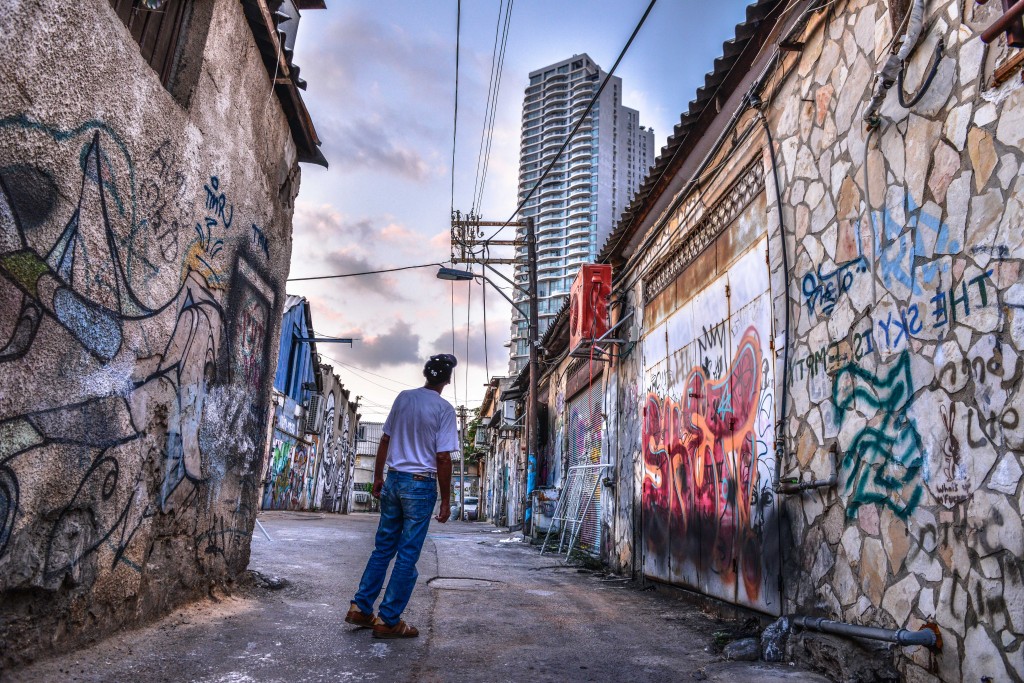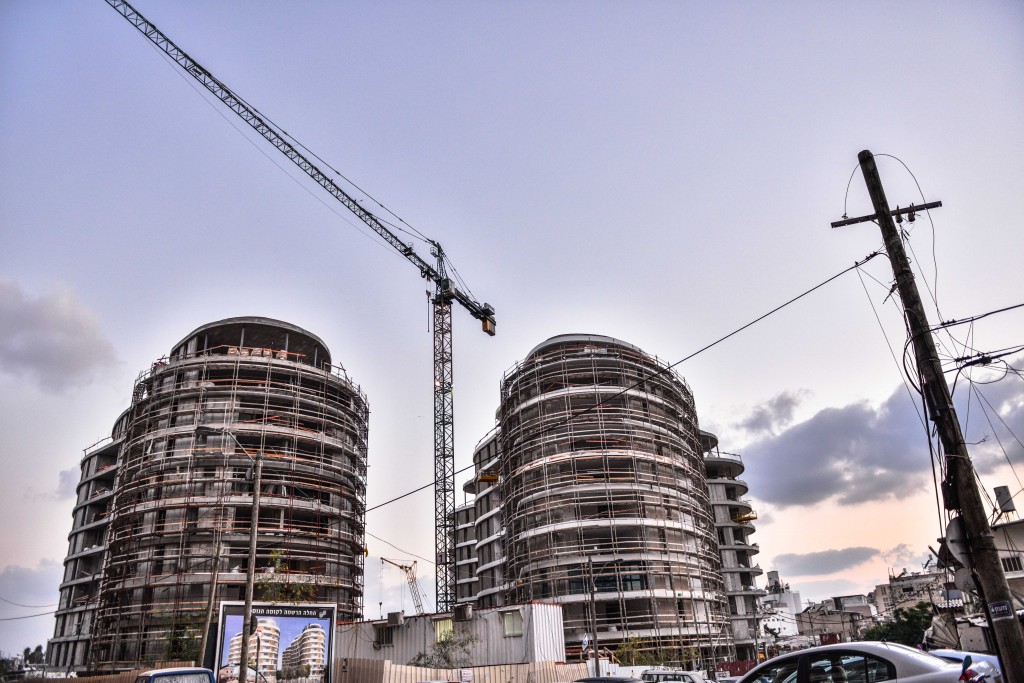Israel’s biggest city is changing, especially in its southern neighborhoods. A walk through them reveals a mixed bag of sights and citizens amid a surprising air of tolerance. Photos: Aviram Valdman
Jaffa is where Tel Aviv really began. The oldest port in the world, once a capital of Canaan, then a bolt hole for both King David and King Solomon, destroyed and rebuilt time and again, the place has been ruled by nearly every great emperor in history.
In the 19th century, as the dream of Palestine gained steam among Zionists across the globe, Jaffa became the gateway for nearly every Jewish dreamer who came to pre-state Palestine. And it was from Jaffa that the nearby neighborhood of Neve Tzedek, now the Soho of Tel Aviv, was born. From this tiny suburb grew the Tel Aviv that is now one of the most talked-about cities in the world.
Today, as you walk south along Tel Aviv’s immaculate coastal boardwalk toward the white stone and the neon green mosque lights of Jaffa, you’ll find yourself at Midron Park. You’d never guess that this gleaming spot, which stretches out toward the Mediterranean in a patchwork of pleasing green spaces, bike trails, and playgrounds, was a massive trash dump until a few years ago. Not coincidentally, the gentrification of south Tel Aviv began creeping into Jaffa around the same time, bringing its boutiques and cafes, a coterie of upper-income residents—and $15 million from the Tel Aviv municipality to transform the dump into an urban paradise.
The completion of Midron Park marks the climax of what might be one of the most extreme and accelerated cases of gentrification in the history of the world. Evolving from a grimy port with ancient roots into an uber-trendy, boutique-lined stronghold in less than a century, Jaffa’s metamorphosis means new hope for the haves of Tel Aviv and new heartache for the have-nots. It’s a familiar tale that has played out around the world, from Williamsburg to Hong Kong. But as in every case of a city or country on the rise, it reveals more than many are willing to admit.
“It felt right to me,” Shlomi Alon, a member of Israel’s biggest hip-hop group, Hadag Nahash, says of his life in Jaffa. “I come from a small town. The people here are more warm and it’s not like Tel Aviv. Tel Aviv is more distant, people can be distant. It’s more like a neighborhood here. More of a community.”
Alon grew up in Tiberias and lived in central Tel Aviv before making his way to the city’s southern fringe. Despite his celebrity, he represents the classic tale of a young, hardworking Israeli trying to make ends meet in a country that, in little more than a decade, has left the leveling mores of its socialist roots behind in favor of the glittering—or gritty, depending on your perspective—realities of the global economy.
Toward the end of the Second Intifada, Tel Aviv was still eminently attainable. Not only was it the economic center of the country, but a young college grad (or budding hip-hop artist) could find a decent apartment, often in a quaintly unkempt Bauhaus building, for a few hundred dollars—and amid the shekel’s instability at the time, rent prices were actually listed in dollars—per month. Similarly, small one- or two-bedroom apartments, even in the best of the city’s neighborhoods, could be had with a mortgage that stretched but didn’t break the combined salary of a young couple looking to start a family.
As the Intifada wound down, however, Israel’s investments in high-tech began to pay dividends. Younger individuals and, in particular, families began to find themselves increasingly priced out of the market by older earners who eroded the relative income (and the purchasing power) of the growing numbers of young Jewish Israelis who were looking to rent or buy. As a result, one study found, by 2009 it took 7.7 years of median income to buy a median-priced home in Israel, compared with 6.8 years in Australia, 5.1 in the UK, and 2.9 years in the U.S. The study also found that, relative to income, Israeli housing “is more expensive than housing in 32 of England’s 33 metropolitan areas (including London), and more expensive than 174 out of America’s 175 metropolitan areas (including New York City).”
Like New York’s artist class, which fled to Downtown and eventually Brooklyn, only to be followed by young real-estate-hungry bourgeoisie, Tel Aviv’s young earners also began looking to southern neighborhoods that their parents wouldn’t have set foot in a decade ago. Neighborhoods like Florentin, which, with its endless rows of dilapidated warehouses, can still look like a case study in the Broken Windows Theory, and Jaffa, whose rougher areas have become synonymous with crime and violence, are starting to look notably more urbane, and at a increasingly rapid pace.
Once an eyesore beneath glimmering Tel Aviv, Jaffa is now the White City’s darling, and as its star rises so have its real estate prices. While the beauty of its renovation is undeniably positive, it is also forcing some of its residents to reconsider their leases.
“We’re doing a lot because it’s a very big issue, all over Israel,” says Ami Katz, who heads up Jaffa affairs for the Tel Aviv-Jaffa municipality. “But it’s more extreme in Jaffa, in many ways, because of the Arab-Jewish conflict. The mixture of a multicultural community makes everything more interesting.”
Rapper Alon, who first left central Tel Aviv for Florentin and then, when the rent crept skyward, departed for Jaffa, says he can see himself moving again in another few years. Alon, of course, has the luxury of being able to leave. For many of Jaffa’s Arab residents who have now been priced out of their neighborhood, and there are fewer options for other welcoming neighborhoods. But Katz and his colleagues insist they are trying to help the residents of Jaffa, to improve their quality of life, not drive them away.
Guy Sharett, a linguist and former journalist, leads a beloved series of graffiti tours around Florentin and Jaffa called Streetwise Hebrew. He guides groups of tourists and locals around the neighborhoods and breaks down the Hebrew words and phrases found in the colorful, enigmatic graffiti splashed across most of their buildings. His tours are anchored in the idea of gentrification and change.
“Look at the SuperPharm just across the street,” he tells me, pointing to a branch of Israel’s biggest drugstore chain at the corner of Herzl and Florentin streets. “It’s nice, it’s nice to go and have a pharmacy and have a pharmacist. And they accept credit cards as opposed to mom and pop shops and there are special deals because they are a big buyer and seller. But on the other hand it could be anywhere. You could be in an outlet mall near Nazareth and there will be a SuperPharm there. So it’s a bit like Starbucks.”
“I don’t know if it’s gentrification,” he says of the neighborhood’s shift. “It’s globalization, it’s individuality as opposed to collectiveness. We used to be a collective, like, ‘I was there because of Zionism, I was there for religion.’ Today it’s ‘I’m here because of me.’”
Sharett’s most popular tour is the Florentin graffiti tour, but he also offers guided trips to Jaffa Port and the Levinsky Spice Market; as well as the experience of watching “Kochav Nolad,” Israel’s version of “American Idol.” Every tour harnesses popular culture and current events and utilizes them as a method for teaching Hebrew, making the experience of learning the language into something tangible and worth remembering.
“It’s not a picture perfect tour by the Ministry of Tourism,” Sharett says. “And I think people miss this, especially tourists, especially Jewish tourists, who went through this brainwash of Sunday school and giving money to Israel. They crave some authenticity not related to donations and not related to Zionism in its old kind of manifestation.”
This southern Tel Aviv hipster hangout of Florentin is quietly morphing from a gritty, litter-strewn enclave of warehouses and creaking apartments into a bastion of edgy bars, farm-to-table restaurants, and yoga-mat toting, tattoo-sporting young couples.
“I have seen all the changes,” says Yomi Yom Tov Levy, 30, who along with his brother runs the Yom Tov Deli, an eclectic little shop of all things mezze (a group of Middle Eastern appetizers usually served together) just outside of Florentin’s Levinsky Market. “I’ve been working here since I was 17, and in those 13 years I have seen all sorts of changes,” he says. “I think it’s a good thing. There are new people here now. New blood.”
The deli, which features Italian olive oil and Turkish olives along with French cheese and Israeli hospitality, has been in the family for three generations, ever since Yomi’s father learned the mezze trade in Istanbul in 1947.
“In the last 10-12 years the Israeli people learned how to eat better. Twelve years before, gouda was the best cheese,” Yomi says. The tastes of the locals have expanded because Israel has become a more global place. “Now all the places have these new foods, and I think it’s a good thing. You don’t need to stay in one place with what you eat. You should be open to everything.”
At Yahaloma, the chic little bistro café half-hidden by the Levinsky spice market, high-end iterations of Egyptian-Israeli gastronomic staples, like hummus, ful (a rich paste of dark fava beans with olive oil, onion, and parsely), and shakshuka, (eggs cooked in spiced tomato sauce), are served to foodies and cultural weekend warriors who flock from the city’s northern districts.
But Yahaloma’s namesake, Yahaloma Levi, who launched the “bistron”—a portmanteau of the French bistro and the Hebrew word for cafeteria, miznon—has misgivings about the role her eatery is playing in the neighborhood’s accelerated evolution.
“I feel like I am failing a bit because most of my customers are not from here,” she says. “It’s a failure and a victory at the same time because it gives an opportunity for people to be exposed to the neighborhood who wouldn’t otherwise come.”
“I can see that my neighbors are changing,” says Said Abulafia, a 32-year-old lawyer whose family built a dynasty out of bakeries and real estate in Jaffa. In one sentence, he sums up the traditional rent-chasing process, the journey taken by Alon and so many others: “When you can’t afford central Tel Aviv, you go to Florentin. When you can’t afford Florentin, you go to Jaffa. Jaffa is much more beautiful than all these places, but it’s a mindset.” A mindset that, in all likelihood, comes from its history. Jaffa, traditionally Arab and low-income, was for decades plagued by a government policy of neglect. Roads crumbled and infrastructure was non-existent.
But Jaffa is now a mixed city known for fairly peaceful coexistence between Arabs and Jews as well as its growing cultural cachet. The Shuk HaPishpishim (literally, “the flea market”) where toothless vendors peddle antique furniture and questionable electric appliances now boasts gastropubs and art galleries. Along the creaking marina, new life has been breathed into Jaffa Port thanks to a farmer’s market designed by high-end architecture team Jacobs-Yaniv and an invasion of live music, edgy art, and culinary creativity.
At the “open-source” eatery Yona, chef Ronen Skinezes, who also runs the kitchen at nearby Manta Ray, uses farm-sourced ingredients and the “slow food” philosophy to bring house-made ricotta, hand-smoked fish, and an elevated Mediterranean flair to his dishes. Next door, the venerable Hazeken Vehayam (“The Old Man and the Sea”), an Arab-run seafood stand that still dishes out a 20-salad appetizer, sits on Kedem Street in south Jaffa. The restaurant’s new incarnation in the shiny, renovated port is sleeker and fresher, earning it a nod (alongside Yona) in The New York Times’ lifestyle magazine.
To Abulafia, whose family has lived in Jaffa for 600 years, the evolution of Jaffa was bound to happen. “Things change. Some of the things are for the better and some are for the worse,” he says. “But if you look back at history, nothing stays the same.” Alon, whose hip hop band is known for being unabashed about its left-leaning views, agrees. With every new chic wine bar and hopelessly expensive t-shirt shop in Jaffa, he says, another step is being taken in a natural evolution, one that has existed as long as cities have been built and peoples have been on the move.
But sanguinity is less of an option for others. After Israel was established in 1948, most of Jaffa’s Arabs fled. The ones who remained moved into homes they did not own or for which they lacked proper documentation. To deal with the issue, the city gave many residents “protected tenancy” agreements, effectively granting them leases that would expire after three generations. In the late 2000s, just as developers starting eyeing the area, many of those agreements expired and families started getting eviction orders. Each time a new boutique t-shirt shop opens, these people face the possibility of losing their homes.
“You have people who feel that they have two choices: to continue living with this cloud over their head that they’re going to be evacuated, or decide to leave,” says Sari Kronisch, an architect who works with Bimkom, an Israeli non-profit that seeks to use city planning to enhance civil rights. “And it feels like they are being expelled from their own homes, their own neighborhood, where their background is.”
“The Arabs in Jaffa are not only victims of random gentrification,” says Jesse Fox, founder of the non-profit Open Tel Aviv, which pushes for transparency in the city planning process. “There’s a nationalistic twist. If you’re talking about a Bulgarian-Jewish family in Jaffa, or in Florentin for that matter, it’s gentrification. If you’re talking about an Arab family, there’s a whole added dimension.”
The municipality’s Ami Katz admits the issue is a thorny one. “Our policy, of course, is not gentrification. Our policy is to give Jaffa what Jaffa needed for so many decades but no one bothered to invest in,” he says. “In Jaffa, there is a special — Arab-Israeli conflict. Most of the Arab population used to live in Ajami and many now find it’s almost impossible to afford housing there.”
To ease the blow of gentrification, Katz says that he and Tel Aviv officials have adopted dozens of initiatives to aid Jaffa’s Arab population. These include building new schools for Arab-speaking students, investing in initiatives to support Arab culture, and pushing for as much affordable housing as possible.
“For the past decade, we have invested a lot of effort in renovating infrastructure in Jaffa, in order to fill gaps in education, culture, etc.,” Katz says. “We’ve invested more than NIS 1 billion, maybe close to NIS 1.5 billion, for infrastructure in Jaffa alone. This process created a situation that raised real estate prices. Because what were once very neglected streets with no gardens, no electricity, nothing, are now totally new. Everything is new, with new gardens and lovely parks. So the value of real estate is jumping up.”
“It’s a symbiotic process,” says Alon, who takes an artist’s view of things. “They’re building at a crazy tempo. There is no parking any more.… So yes, it’s annoying. But on the other hand, I have great cafes and wonderful people coming in. They’re intellectual people, creative people. So it’s a good process. You have the good with the bad.”
![]()
Banner Photo: Aviram Valdman / The Tower






